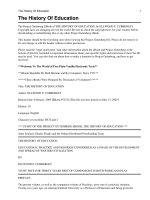A History of Writing one of the earliest examples of writing, a 4th millennium tablet from Uruk, lists sacks of grain and heads of cattle ppt
Bạn đang xem bản rút gọn của tài liệu. Xem và tải ngay bản đầy đủ của tài liệu tại đây (2.68 MB, 32 trang )
A History of Writing
one of the earliest examples of writing, a 4th millennium tablet from Uruk, lists sacks of grain and heads of cattle
The earliest writing seems to be an accounting device to
record inventory.
Clay tokens were used for this purpose in the Mediterranean as early
as 8000 BCE and were common by 4000 BCE.
Clay tablets from Sumer, c. 3200 BCE, show early pictographic
writing, which later became wedge-shaped cuneiform . . .
Univ of Chicago Oriental Institute
Cuneiform, literally
‘wedge-shaped’
writing on baked
clay tablets,
was first used ca.
3000 BCE in
Mesopotamia
wedges were easier to carve
than curved lines
Writing was invented multiple times in many places on
earth . . .
the earliest Chinese writing was “oracle bone” script,
inscribed on tortoise shell or ox bone during the Shang
Dynasty, ca. 1600 - 1000 BCE.
United College, Hong Kong
priests burned the shell or bone,
then read the cracks as good or
bad omens
This Chinese calligraphic poem
is written on silk and dates from
the Song dynasty, 900 - 1279 CE
Taipei Museum
by this time, Chinese writing has
clearly become ideographic rather
than pictographic
Chinese characters are sometimes simplified
traditional characters
still used in Taiwan
and elsewhere
simplified
version, used
for Mandarin
Another pictographic writing
system developed in meso-
America.
The Dresden Codex is one of
four surviving pre-Columbian
Mayan manuscripts.
The script, recently deciphered,
uses symbols that stand for
sounds and whole words.
The Noso or Naxi live in Yunnan province, in China,
and use a pictographic writing system
as a mnemonic for priests. 19th c.
The Egyptian Book
of the Dead
the hieroglyphs, which
contain both semantic
and phonetic information,
read, “the great god, fore-
most of the west, that
he may give a good
burial to the god’s
father of Amun-Re,
king of gods,
Pawiaenadja, true of
voice.
The arrow points to
an apparent “scribo”
The Rosetta Stone
was carved around
290 BCE and was
discovered in 1799;
it contains 3 scripts:
hieroglyphic, demotic
Egyptian, and Greek
The Cascajal Stone, found in
Veracruz, Mexico, contains a
3,000-year-old, previously unknown
script, making it the oldest writing in
the Western hemisphere.
It is probably Olmec in origin and
pushes New World writing back to
ca. 900 BCE.
Some of the 62 signs on the stone
slab are repeated and none have
been deciphered.
The stone measures 14 x 8 inches,
is about 5" thick, and weighs 26
lbs.
The last discovery of an unknown
writing system occurred in 1924 in
the Indus Valley.
Phoenician writing
emerges ca. 1200 BCE;
all 22 symbols were
consonants the vowels
weren’t written
Archaic Greek writing
adapts Phoenician
script, c. 750 - 500 BCE
is the Greek alphabet a major
development, or a minor
improvement on an older
form of writing?
The first page of the
Beowulf manuscript.
The poem was composed
between 680 and 800 CE,
and the ms. dates from the
10th or 11th c.
The sole copy was damaged
in a fire in the late 18th c.
The futharc is a runic system used in Anglo-Saxon
England and parts of Europe, mainly for
inscriptions
The Franks Casket, dating from the
7th or 8th century, is inscribed with runes
as well as illustrations …
In the 15th c., King Sejong
commissioned a group of scholars
to create a Korean alphabet, now
called Hangul, to free Korea
of the influence of Chinese writing.
The earliest Japanese writing, dating from the 8th c., and
perhaps as early as the 6th c., is called manyogana and
uses Chinese characters (right column) to represent
Japanese phonetic values (left column).
the character segment
in red was adapted to
form the katakana on
the left
Today,
Japanese
uses four
different
writing
systems:
romaji, Roman letters re-
presenting Japanese
sounds
hiragana, ordinary
syllabic script;
katakana, which derives
from Chinese characters,
and is used for writing
non-Chinese loan words;
and kanji, Chinese
characters used to
represent Japanese
words
Devanagari script was first developed to write Sanskrit in
the 12th c. CE, and is now used for Hindi and other
South Asian languages
Pictographs still play an important
role in our communication
practices:
Not all pictographs
are immediately
comprehensible…
Not just signs, but puzzles as well:
Here’s a patriotic
letter in the form
of a rebus…









